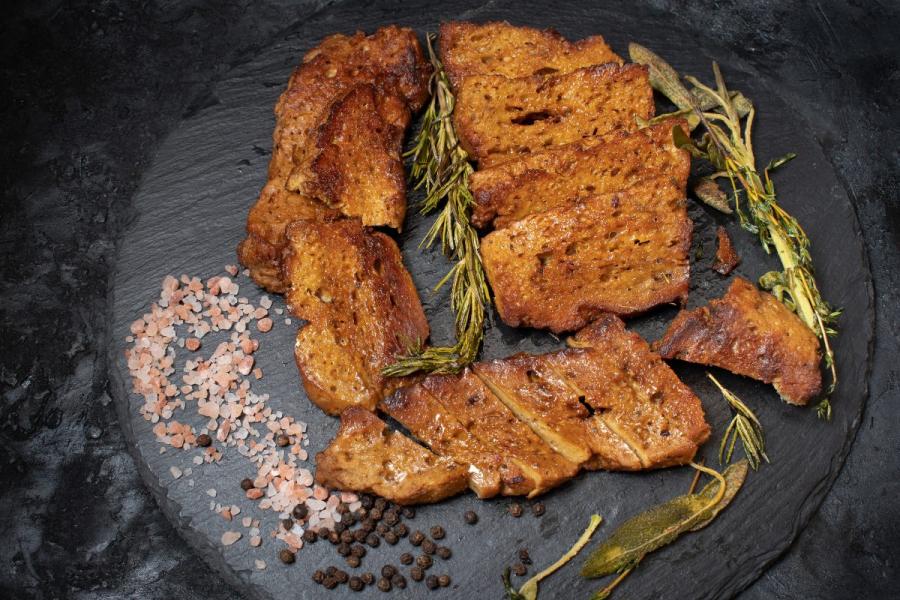Seitan
Seitan is a versatile plant-based protein.
Seitan, also known as wheat meat or wheat gluten, is a popular plant-based protein source made from wheat gluten.
Seitan from wheat gluten
To make seitan, wheat gluten is mixed with water and sometimes other ingredients like spices, nutritional yeast, and vegetable broth. The dough is then kneaded and rinsed to remove the starch and other components, leaving behind a chewy, high-protein mass.
Seitan has a meat-like texture and can be flavored to mimic the taste of beef, chicken, or pork. It is also a good source of protein, low in fat, and contains no cholesterol, making it a healthy alternative to animal protein.
Nutrition
Seitan has several potential benefits as a plant-based protein source.
- High in protein: Seitan is an excellent source of plant-based protein, containing about 25 grams of protein per 100 grams. This makes it a good choice for vegans and vegetarians who may have trouble meeting their protein needs through other plant-based sources.
- Low in fat: Seitan is naturally low in fat, making it a healthy alternative to meat, which is typically higher in saturated fat.
- Cholesterol-free: Seitan contains no cholesterol, which is important for heart health.
- Versatile: Seitan can be flavored and cooked in many different ways, making it a versatile ingredient in a variety of dishes.
- Sustainable: Seitan is made from wheat gluten, which is a byproduct of the wheat flour industry. This means it is a more sustainable protein source compared to meat, which requires more resources to produce.
However, it's important to note that some people may have gluten intolerance or celiac disease, which means they cannot consume seitan or other wheat-based products. Additionally, seitan may not be a complete protein source on its own and should be combined with other plant-based protein sources like legumes and nuts to ensure adequate nutrient intake.
Seitan preparation and cooking
Seitan is a versatile ingredient and can be cooked in many different ways. The cooking time and method will depend on the recipe you're making and the texture of the seitan. Always follow the cooking instructions provided in the recipe or on the packaging of your seitan.
Pan-frying
Slice the seitan into desired shapes and sizes and pan-fry in a little oil until golden brown on both sides. You can season it with spices or sauces to add flavor.
Baking
Cut seitan into cubes, slices or strips, and place on a baking sheet. Brush with oil and seasonings, and bake in the oven for about 20-30 minutes until golden brown and crispy.
Grilling
Marinate seitan in your favorite sauce, then grill on medium heat for 5-7 minutes per side until charred and crispy.
Boiling
Cut seitan into desired shapes and sizes and simmer in a flavorful broth or vegetable stock for 20-30 minutes until tender. This method is commonly used for seitan dumplings or in stews.
Stir-frying
Cut seitan into thin slices and stir-fry with vegetables and sauce until everything is cooked through and the sauce is absorbed.
Substitutions
Seitan can be susbstituted in recipes with the same weight of tempeh, extra-firm tofu, portobello mushroom caps, prepared vegetarian meat substitute.
Tempeh has a stronger flavor than seitan. Portobello mushrooms will add the mushroom flavor.
If uisng frozen tofu, should be defrosted first. Tofu should be drained and pressed to remove all liquid, even so, the texture will be softer.
Vegetarian meat substitutes are usually available in the refrigerated and frozen foods sections.
History of seitan
Seitan has its origins in East Asian cuisine, particularly in China and Japan, where it has been used for centuries as a meat substitute in vegetarian and Buddhist diets.
In China, seitan is known as "mianjin" or "wheat muscle" and is used in dishes like vegetarian dumplings and stir-fries. In Japan, it is called "fu" or "wheat gluten" and is commonly used in vegetarian dishes like sukiyaki and tempura.
Today, seitan has become popular worldwide as a plant-based protein source for vegans and vegetarians, as well as for people looking to reduce their meat consumption. It is commonly found in health food stores and can also be made at home with wheat gluten and other ingredients.

